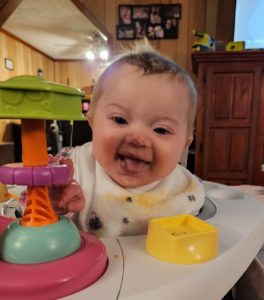DOWNLOAD STATE FACT SHEET AS PDF

In 2020, there were 51,668 live births in Kentucky 2 There are 59 conditions on the Kentucky Newborn Screening Panel 3
All babies in the United States are screened for several conditions shortly after birth. Approximately 24-48 hours after a baby is born in the United States, the heel is pricked by a nurse to collect a small sample of blood. Afterward, the nurse puts a series of blood drops onto a filter paper to create several “dried blood spots.” Next, the newborn screening card is sent to the state laboratory for analysis. KY started screening for Krabbe disease shortly after the implementation of Anna’s Law in April 2015. Since the implementation of this law, KrabbeConnect reports that 2 patients have been able to access treatment due to obtaining an early diagnosis through newborn screening.
What is Krabbe Disease?
Krabbe disease (pronounced krab A) is a rare genetic disorder known as globoid cell leukodystrophy. In the United States, Krabbe disease has been reported to affect approximately 1 in 100,000 individuals. 1 Infantile Krabbe disease is the most common and severe form causing infants to lose the ability to eat, extreme irritability, inability to sit up, and grasp objects, blindness, and seizures. Sadly, infants die within the first 2-3 years of life in states that do not test for Krabbe disease. We invite you to learn more about Understanding Krabbe Disease.
Why Screen for Krabbe Disease?
Krabbe disease is a severe neurodegenerative and rapidly progressing condition requiring immediate treatment for the most severe forms. Emmalynn was diagnosed with an early onset form of Krabbe disease which requires an early diagnosis to ensure treatment occurs within the first 30-45 days of life. However, the medical issues and symptoms of any form of Krabbe disease are significant and life-impacting. A delayed diagnosis, especially in the most severe forms, equates to palliative and supportive care as the only means of treatment until premature death.
Krabbe Disease Hero: Emmalynn Absher

See all our Krabbe Disease Heroes.
Allie and James Absher welcomed Emmalynn into their lives and were ready to start their life as a family of four. However, a phone call from a geneticist changed everything. The geneticist told them that Emmalynn’s Newborn Screening test results were abnormal and asked them to bring her in a few days later for further testing. Not long afterward, Emmalynn was diagnosed with Krabbe disease and the family headed to Pittsburgh for treatment.
Emmalynn spent several months in the hospital undergoing a stem-cell transplant. It was not an easy treatment to watch their baby girl undergo however, they were so thankful a treatment was available for their precious little girl. After 6 long months, Emmalynn returned home to her dad and big sister in Kentucky. Allie and James are so proud of Emmalynn and say that she is the light of their lives. She is strong and continues to improve with each passing day. The Absher family can’t wait to see what the future holds for Emmalynn.
Legislation was passed in March 2015 requiring all newborns to be screened for Krabbe disease. Bill SB-75, also known as the Anna Claire Taylor law, came to fruition as a result of the grassroots advocacy efforts of Sarai and Nathan Taylor. If Anna was born just over the border in Missouri, her newborn screening test would have alerted her parents of this fatal disease in the first few days of life allowing her the opportunity to undergo the same treatment Emmalynn received. Anna lost her battle with the disease in April 2015.
Resources
- The Leukodystrophy Newborn Screening Action Network is dedicated to advancing newborn screening for leukodystrophies and lysosomal storage disorders, supporting newly-diagnosed families, and ensuring collaboration between all stakeholders. Learn more at https://ldnbs.org/.
- CDC offers funding and assistance through the Newborn Screening Quality Assurance Program (NSQAP). More information can be found at https://www.cdc.gov/labstandards/nsqap.html.
- Baby’s First Test provides funding opportunities through grants. Learn more at https://www.babysfirsttest.org/newborn-screening/funding-opportunities.
- American Public Health Laboratories NewSTEPS program provides data, technical assistance, and training. Details at https://www.newsteps.org/.
- KrabbeConnect offers patient support services to help families navigate the burden of Krabbe disease. Learn more at https://krabbeconnect.org/.
- Hunter’s Hope Foundation is a non-profit organization committed to giving hope through education, awareness, research, and family care for all leukodystrophies. Learn more at https://www.huntershope.org/.
Citations
- Wenger DA. Krabbe Disease. 2000 Jun 19 [Updated 2011 Mar 31]. In: Pagon RA, Adam MP, Ardinger
HH, et al., editors. GeneReviews® [Internet]. Seattle (WA): University of Washington, Seattle; 1993-2017. - “Fertility Rate: Kentucky, 2010-2020.” March of Dimes | PeriStats, https://www.marchofdimes.org/peristats/data?reg=99&top=2&stop=1&lev=1&slev=4&obj=1&sreg=26. Accessed 6 Sep. 2022.
- “Kentucky | Baby’s First Test | Newborn Screening | Baby Health.” Babysfirsttest.org, 2015, https://www.babysfirsttest.org/newborn-screening/states/kentucky. Accessed 6 Sept. 2022.
- Dixon, J. J. “Governor Signs Anna’s Law Bill.” WLKY, 24 Mar. 2015, www.wlky.com/article/govenor-signs-annas-
law-bill/3756839. Accessed 12 Sept. 2022.
All information in this fact sheet is based on data available before September 9, 2022.


